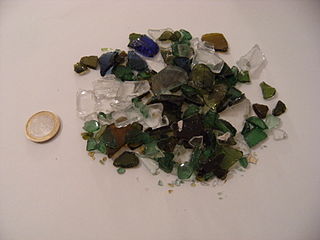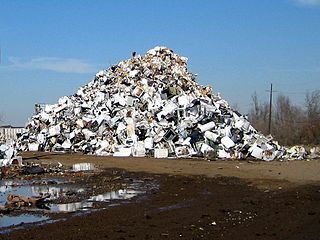
A router is a hand tool or power tool that a worker uses to rout an area in relatively hard material like wood or plastic. Routers are mainly used in woodworking, especially cabinetry. Routers are typically handheld or fastened cutting end-up in a router table.

Recycling is the process of converting waste materials into new materials and objects. It is an alternative to "conventional" waste disposal that can save material and help lower greenhouse gas emissions. Recycling can prevent the waste of potentially useful materials and reduce the consumption of fresh raw materials, thereby reducing: energy usage, air pollution, and water pollution.

Incineration is a waste treatment process that involves the combustion of organic substances contained in waste materials. Incineration and other high-temperature waste treatment systems are described as "thermal treatment". Incineration of waste materials converts the waste into ash, flue gas and heat. The ash is mostly formed by the inorganic constituents of the waste and may take the form of solid lumps or particulates carried by the flue gas. The flue gases must be cleaned of gaseous and particulate pollutants before they are dispersed into the atmosphere. In some cases, the heat generated by incineration can be used to generate electric power.

The Waste Electrical and Electronic Equipment Directive is the European Community Directive 2012/19/EU on waste electrical and electronic equipment (WEEE) which, together with the RoHS Directive 2011/65/EU, became European Law in February 2003. The WEEE Directive set collection, recycling and recovery targets for all types of electrical goods, with a minimum rate of 4 kilograms per head of population per annum recovered for recycling by 2009. The RoHS Directive set restrictions upon European manufacturers as to the material content of new electronic equipment placed on the market.

Atrophy is the partial or complete wasting away of a part of the body. Causes of atrophy include mutations, poor nourishment, poor circulation, loss of hormonal support, loss of nerve supply to the target organ, excessive amount of apoptosis of cells, and disuse or lack of exercise or disease intrinsic to the tissue itself. In medical practice, hormonal and nerve inputs that maintain an organ or body part are said to have trophic effects. A diminished muscular trophic condition is designated as atrophy. Atrophy is reduction in size of cell, organ or tissue, after attaining its normal mature growth. In contrast, hypoplasia is the reduction in size of a cell, organ, or tissue that has not attained normal maturity.

A leachate is any liquid that, in the course of passing through matter, extracts soluble or suspended solids, or any other component of the material through which it has passed.

A punch press is a type of machine press used to cut holes in material. It can be small and manually operated and hold one simple die set, or be very large, CNC operated, with a multi-station turret and hold a much larger and complex die set.

A skip is a large open-topped waste container designed for loading onto a special type of lorry. Instead of being emptied into a bin lorry on site, as a wheelie bin is, a skip is removed, or replaced by an empty skip, and then tipped at a landfill site or transfer station.

Glass recycling is the processing of waste glass into usable products. Glass that is crushed and ready to be remelted is called cullet. There are two types of cullet: internal and external. Internal cullet is composed of defective products detected and rejected by a quality control process during the industrial process of glass manufacturing, transition phases of product changes and production offcuts. External cullet is the waste glass that is collected and/or reprocessed with the purpose of recycling. External cullet is classified as waste. When using the word "cullet" in the context of end-of-waste it will always refer to external cullet.
EnergySolutions, headquartered in Salt Lake City, Utah, is one of the world's largest processors of low level waste (LLW), and is the largest nuclear waste company in the United States. It was founded by Steve Creamer in 2007 through the merger of four waste disposal companies: Envirocare, Scientech D&D, BNG America, and Duratek.
A mechanical biological treatment system is a type of waste processing facility that combines a sorting facility with a form of biological treatment such as composting or anaerobic digestion. MBT plants are designed to process mixed household waste as well as commercial and industrial wastes.
Environmental Waste Controls plc (EWC) is a privately held Merseyside- based UK company, who provide waste management and recycling solutions for various types of industry. It was first founded by Bill Edwards in 1993, who initially started the business from his bedroom; the concept was to offer a total transparent and fixed-price waste and recycling management package.
The Landfill Directive, more formally Council Directive 1999/31/EC of 26 April 1999 is a European Union directive that regulates waste management of landfills in the European Union. It was implemented by its Member States by 16 July 2001.
Biodegradable waste includes any organic matter in waste which can be broken down into carbon dioxide, water, methane or simple organic molecules by micro-organisms and other living things by composting, aerobic digestion, anaerobic digestion or similar processes. In waste management, it also includes some inorganic materials which can be decomposed by bacteria. Such materials include gypsum and its products such as plasterboard and other simple organic sulfates which can decompose to yield hydrogen sulphide in anaerobic land-fill conditions.

In 2015, 43.5% of the United Kingdom’s municipal waste was recycled, composted or broken down by anaerobic digestion. The majority of recycling undertaken in the United Kingdom is done by statutory authorities, although commercial and industrial waste is chiefly processed by private companies. Local Authorities are responsible for the collection of municipal waste and operate contracts which are usually kerbside collection schemes. The Household Waste Recycling Act 2003 required local authorities in England to provide every household with a separate collection of at least two types of recyclable materials by 2010. Recycling policy is devolved to the administrations of Scotland, Northern Ireland and Wales who set their own targets, but all statistics are reported to Eurostat.
Biomedical waste is any kind of waste containing infectious materials. It may also include waste associated with the generation of biomedical waste that visually appears to be of medical or laboratory origin, as well research laboratory waste containing biomolecules or organisms that are many restricted from environmental release. As detailed below, discarded sharps are considered biomedical waste whether they are contaminated or not, due to the possibility of being contaminated with blood and their propensity to cause injury when not properly contained and disposed of. Biomedical waste is a type of biowaste.

Waste management laws govern the transport, treatment, storage, and disposal of all manner of waste, including municipal solid waste, hazardous waste, and nuclear waste, among many other types. Waste laws are generally designed to minimize or eliminate the uncontrolled dispersal of waste materials into the environment in a manner that may cause ecological or biological harm, and include laws designed to reduce the generation of waste and promote or mandate waste recycling. Regulatory efforts include identifying and categorizing waste types and mandating transport, treatment, storage, and disposal practices.

Demolition, or razing, is the science and engineering in safely and efficiently tearing down of buildings and other man-made structures. Demolition contrasts with deconstruction, which involves taking a building apart while carefully preserving valuable elements for reuse purposes.

Appliance recycling is the process of dismantling waste home appliances and scrapping their parts for reuse. Recycling appliances for their original or other purposes, involves disassembly, removal of hazardous components and destruction of the end-of-life equipment to recover materials, generally by shredding, sorting and grading. The rate at which appliances are discarded has increased with technological advancement. This correlation directly leads to the question of appropriate disposal. The main types of appliances that are recycled are televisions, refrigerators, air conditioners, washing machines, and computers. When appliances are recycled, they can be looked upon as valuable resources. If disposed of improperly, appliances can become environmentally harmful and poison ecosystems.
India produced 62 Million Tonnes of Municipal Solid Waste (MSW) in 2016. Of this approximately 50% was organic or biodegradable waste, 18% was recyclable waste and 32% was inert waste. It is estimated that 75-80% of MSW generated in India is collected and 22-28% of it is processed and treated. With changing lifestyles and consumption patterns MSW generation in India is likely to increase to 165 Million Tonnes by 2030.














